| Home · All Classes · Main Classes · Grouped Classes · Modules · Functions |
The QLineF class provides a two-dimensional vector using floating point precision. More...
#include <QLineF>
The QLineF class provides a two-dimensional vector using floating point precision.
A QLineF describes a finite length line (or line segment) on a two-dimensional surface. QLineF defines the start and end points of the line using floating point accuracy for coordinates. Use the toLine() function to retrieve an integer based copy of this line.
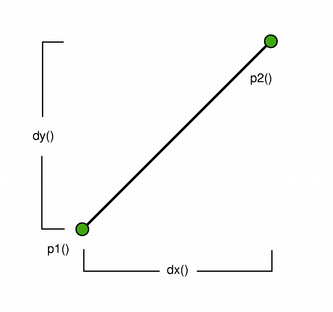 | 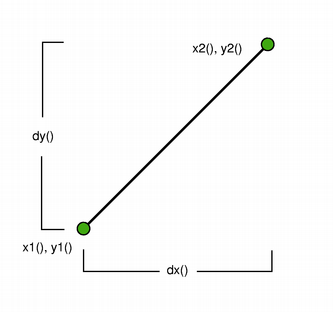 |
The positions of the line's start and end points can be retrieved using the p1(), x1(), y1(), p2(), x2(), and y2() functions. The dx() and dy() functions return the horizontal and vertical components of the line, respectively.
The line's length can be retrieved using the length() function, and altered using the setLength() function. Use the isNull() function to determine whether the QLineF represents a valid line or a null line.
The intersect() function determines the IntersectType for this line and a given line, while the angle() function returns the angle between the lines. In addition, the unitVector() function returns a line that has the same starting point as this line, but with a length of only 1, while the normalVector() function returns a line that is perpendicular to this line with the same starting point and length.
Finally, the line can be translated a given offset using the translate() function, and can be traversed using the pointAt() function.
See also QLine, QPolygonF, and QRectF.
Describes the intersection between two lines.
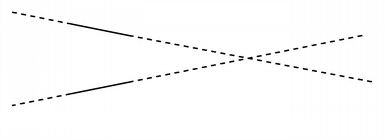 | 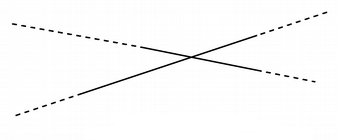 |
| QLineF::UnboundedIntersection | QLineF::BoundedIntersection |
| Constant | Value | Description |
|---|---|---|
| QLineF::NoIntersection | 0 | Indicates that the lines do not intersect; i.e. they are parallel. |
| QLineF::UnboundedIntersection | 2 | The two lines intersect, but not within the range defined by their lengths. This will be the case if the lines are not parallel. |
| QLineF::BoundedIntersection | 1 | The two lines intersect with each other within the start and end points of each line. |
See also intersect().
Constructs a null line.
Constructs a line object that represents the line between p1 and p2.
Constructs a line object that represents the line between (x1, y1) and (x2, y2).
Construct a QLineF object from the given integer-based line.
See also toLine().
Returns the line's start point.
See also x1(), y1(), and p2().
Returns the line's end point.
See also x2(), y2(), and p1().
Returns the x-coordinate of the line's start point.
See also p1().
Returns the x-coordinate of the line's end point.
See also p2().
Returns the y-coordinate of the line's start point.
See also p1().
Returns the y-coordinate of the line's end point.
See also p2().
Returns the angle (in degrees) between this line and the given line, taking the direction of the lines into account. If the lines do not intersect within their range, it is the intersection point of the extended lines that serves as origo (see QLineF::UnboundedIntersection).
 | 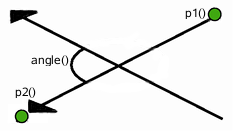 |
When the lines are parallel, this function returns 0 if they have the same direction; otherwise it returns 180.
See also intersect().
Returns the horizontal component of the line's vector.
Returns the vertical component of the line's vector.
Returns a value indicating whether or not this line intersects with the given line.
The actual intersection point is extracted to intersectionPoint (if the pointer is valid). If the lines are parallel, the intersection point is undefined.
Returns true if the line is not set up with valid start and end point; otherwise returns false.
Returns the length of the line.
See also setLength().
Returns a line that is perpendicular to this line with the same starting point and length.
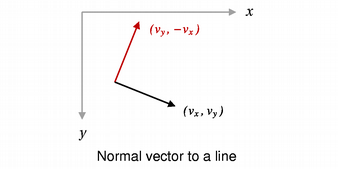
See also unitVector().
Returns the point at the parameterized position specified by t. The function returns the line's start point if t = 0, and its end point if t = 1.
Sets the length of the line to the given length. If the line is a null line, the length will remain zero regardless of the length specified.
See also length() and isNull().
Returns an integer based copy of this line.
Note that the returned line's start and end points are rounded to the nearest integer.
See also QLineF().
Translates this line by the given offset.
This is an overloaded member function, provided for convenience.
Translates this line the distance specified by dx and dy.
Returns the unit vector for this line, i.e a line starting at the same point as this line with a length of 1.0.
See also normalVector().
Returns true if the given line is not the same as this line.
A line is different from another line if their start or end points differ, or the internal order of the points is different.
Returns true if the given line is the same as this line.
A line is identical to another line if the start and end points are identical, and the internal order of the points is the same.
This is an overloaded member function, provided for convenience.
Writes the given line to the given stream and returns a reference to the stream.
See also Format of the QDataStream Operators.
This is an overloaded member function, provided for convenience.
Reads a line from the given stream into the given line and returns a reference to the stream.
See also Format of the QDataStream Operators.
| Copyright © 2007 Trolltech | Trademarks | Qt 4.2.3 |